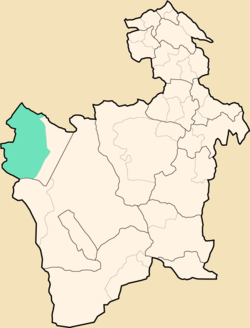Llica Municipality
From Wikipedia, the free encyclopedia
| Llica Municipality | |
|---|---|
| Municipality | |
 | |
 | |
 Llica Municipality | |
| Coordinates: 20°10′S 68°22′W / 20.167°S 68.367°WCoordinates: 20°10′S 68°22′W / 20.167°S 68.367°W | |
| Country |
|
| Department | Potosí Department |
| Province | Daniel Campos Province |
| Seat | Llica |
| Area | |
| • Total | 1,263 sq mi (3,272 km2) |
| Elevation | 13,000 ft (4,000 m) |
| Population (2001) | |
| • Total | 2,901 |
| • Ethnicities | Aymara |
| Time zone | -4 (UTC-4) |
Llica Municipality is the first municipal section of the Daniel Campos Province in the Potosí Department in Bolivia. Its seat is Llica.
The municipality is situated on the western side of the Salar de Uyuni bordering Tahua Municipality. To the north it is bordered by the Oruro Department, to the south by the Nor Lipez Province and to the west by Chile.
Subdivision
The municipality consists of the following cantons:
- Cahuana
- Canquella
- Chacoma
- Llica
- Palaya
- San Pablo de Napa
- Tres Cruces
The people
The people are predominantly indigenous citizens of Aymara descent.[1]
| Ethnic group | % |
|---|---|
| Quechua | 5.7 |
| Aymara | 86.9 |
| Guaraní, Chiquitos, Moxos | 0.1 |
| Not indigenous | 7.1 |
| Other indigenous groups | 0.3 |
See also
- Ch'alla Qullu
- Ch'aphi Qullu
- Iru Phutunqu
- Waylla
- Wila Qullu
References
- ↑ obd.descentralizacion.gov.bo/municipal/fichas/ (inactive)
External links
| ||||||||||||||
This article is issued from Wikipedia. The text is available under the Creative Commons Attribution/Share Alike; additional terms may apply for the media files.
